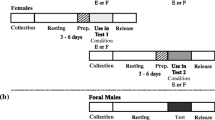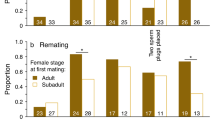Abstract
Three hypotheses for the function of postcopulatory mate guarding were tested in the field cricket Gryllus bimaculatus De Geer. The duration of spermatophore attachment was greater in the absence than in the presence of a guarding male. The ejaculate protection hypothesis was, therefore, rejected. The duration of mate guarding was found to be equal to the interval between copulations, supporting the spermatophore renewal hypothesis. In support of the rival exclusion hypothesis, the presence of a guarding male did increase the duration of spermatophore attachment when a rival male was also present. The presence of a guarding male also delayed the female from mating with the rival male. Female mating status had a significant effect on the duration of spermatophore attachment. Females mating for the first time retained the spermatophore for a significantly longer period of time than females that had mated previously.
Similar content being viewed by others
REFERENCES
Alcock, J. (1994). Postinsemination associations between males and females in insects: The mate guarding hypothesis. Annu. Rev. Entomol. 39: 1-21.
Alexander, R. D. (1961). Aggressiveness, territoriality, and sexual behavior in field crickets (Orthoptera: Gryllidae). Behaviour 17: 130-223.
Andrade, M. C. B., and Mason, A. C. (2000). Male condition, female choice, and extreme variation in repeated mating in a scaly cricket, Ornebius aperta (Orthoptera: Gryllidae: Mogoplistinae). J. Insect Behav. 13: 483-497.
Bateman, P. W. (1998a). Assortative mating by both sexes in the cricket Platygryllus primiformis (Orthoptera: Gryllidae; Gryllinae). Trans. Am. Entomol. Soc. 124: 63-68.
Bateman, P. W. (1998b). Mate preference for novel partners in the cricket Gryllus bimaculatus. Ecol. Entomol. 23: 473-475.
Bateman, P. W., and MacFadyen, D. N. (1999). Mate guarding in the cricket Gryllodes sigillatus: Influence of multiple potential partners. Ethology 105: 949-957.
Bateman, P. W., and Toms, R. B. (1998). Mating, mate guarding and male-male relative strength assessment in an African king cricket (Orthoptera: Mimnermidae). Trans. Am. Entomol. Soc. 124: 69-75.
Bateman, P. W., Gilson, L. N., and Ferguson, J. W. H. (2001a). Male size and sequential mate preference in the cricket Gryllus bimaculatus. Anim. Behav. 61: 631-637.
Bateman, P. W., Gilson, L. N., and Ferguson, J. W. H. (2001b). Investment in mate guarding may compensate for constraints on ejaculate production in the cricket Gryllodes sigillatus. Ethology 107: 1087-1098.
Brown, W. D., and Gwynne, D. T. (1997). Evolution and mating in crickets, katydids and weta (Ensifera). in Gangwere, S. K., Muralirangen, M. C., and Muralirangen, M. (eds.), The Bionomics of Grasshoppers, Katydids and Their Kin, CAB International, Wallingford, England, pp. 281-314.
Evans, A. R. (1988). Mating systems and reproductive strategies in three Australian gryllid crickets: Bobilla victoriae Otte, Balamara gidya Otte and Teleogryllus commodus Walker (Orthoptera: Gryllidae: Nemobiinae; Trigonidiinae; Gryllinae). Ethology 78: 21-52.
Frankino, W. A., and Sakaluk, S. K. (1994). Post-copulatory mate guarding delays promiscuous mating by female decorated crickets. Anim. Behav. 48: 1479-1481.
Hall, M. D., Beck, R., and Greenwood, M. (1999). The developmental morphology of the spermatophore of Gryllus bimaculatus. J. Invert. Reprod. Dev. 36: 117-121.
Hockham, L. R., and Vahed, K. (1997). The function of mate guarding in a field cricket (Orthoptera: Gryllidae; Teleogyrllus natalensis Otte & Cade). J. Insect Behav. 10: 247-256.
Hofmann, H. A., and Schildberger, K. (2001). Assessment of strength and willingness to fight during aggressive encounters in crickets. Anim. Behav. 62: 337-348.
Johnstone, R. A., and Keller, L. (2000). How males can gain by harming their mates: sexual conflict, seminal toxins, and the cost of mating. Am. Nat. 156: 368-377.
Khazraie, K., and Campan, M. (1997). Stability of dyadic dominance status and recognition of the opponent in male crickets Gryllus bimaculatus (Orthoptera: Gryllidae). Behav. Proc. 40: 27-34.
Khazraie, K., and Campan, M. (1999). The role of prior agonistic experience in dominance relationships in male crickets Gryllus bimaculatus (Orthoptera: Gryllidae). Behav. Proc. 44: 341-348.
Loher, W., and Rence, B. (1978). The mating behaviour of Teleogryllus commodus (Walker) and its central and peripheral control. Z. Tierpsychol. 46: 225-259.
Morrow, E. H., and Gage, M. J. G. (2001). Sperm competition experiments between lines of crickets producing different sperm lengths. Proc. R. Soc. Lond. B 268: 2281-2286.
Ono, T., Hayakawa, F., Matsuura, Y., Shiraishi, M., Yasui, H., Nakamura, T., and Arakawa, M. (1995). Reproductive biology and function of multiple mating in the mating system of a tree cricket, Truljalia hibinonis (Orthoptera: Podoscritinae). J. Insect Behav. 8: 813-824.
Preston-Mafham, K. (2000). Diurnal mating behaviour of a Nisitrus sp. cricket (Orthoptera: Gryllidae) from Sumatra. J. Nat Hist. 34: 2241-2250.
Sadowski, J. A., Grace, J. L., and Moore, A. J. (2002). Complex courtship behaviour in the striped ground cricket Allonemobius socius (Orthoptera: Gryllidae): Does social environment affect male and female behavior? J. Insect Behav. 15: 69-84.
Sakaluk, S. K. (1984). Male crickets feed females to ensure complete sperm transfer. Science 223: 609-610.
Sakaluk, S. K. (1991). Post-copulatory mate guarding in decorated crickets. Anim. Behav. 41: 207-216.
Simmons, L. W. (1986a). Female choice in the field cricket Gryllus bimaculatus (De Geer). Anim. Behav. 34: 1463-1470.
Simmons, L. W. (1986b). Inter-male competition and mating success in the field cricket, Gryllus bimaculatus (De Geer). Anim. Behav. 34: 567-579.
Simmons, L. W. (1987). Sperm competition as a mechanism of female choice in the field cricket Gryllus bimaculatus (De Geer). Behav. Ecol. Sociobiol 21: 197-202.
Simmons, L. W. (1988a). Male size, mating potential and lifetime reproductive success in the field cricket, Gryllus bimaculatus (De Geer). Anim. Behav. 36: 372-379.
Simmons, L. W. (1988b). The contribution of multiple mating and spermatophore consumption to the lifetime reproductive success of female field crickets (Gryllus bimaculatus). Ecol. Entomol. 13: 57-69.
Simmons, L. W. (1990). Post-copulatory guarding, female choice and the levels of gregarine infection in the field crickets Gryllus bimaculatus. Behav. Ecol. Sociobiol 26: 403-407.
Simmons, L. W. (1991a). On the post-copulatory guarding behaviour of male field crickets. Anim. Behav. 42: 504-505.
Simmons, L. W. (1991b). Female choice and the relatedness of mates in the field cricket, Gryllus bimaculatus. Anim. Behav. 41: 493-501.
Simmons, L. W. (2001). The evolution of polyandry: An examination of the genetic incompatibility and good-sperm hypotheses. J. Evol. Biol. 14: 585-594.
Tachon, G., Murray, A.-M., Gray, D. A., and Cade, W. H. (1999). Agonistic displays and the benefits of fighting in the field cricket Gryllus bimaculatus. J. Insect Behav. 12: 533-543.
Tregenza, T., and Wedell, N. (1997). Definitive evidence for cuticular pheromones in a cricket. Anim. Behav. 54: 979-984.
Tregenza, T., and Wedell, N. (1998). Benefits of multiple mates in the cricket Gryllus bimaculatus. Evolution 52: 1726-1730.
Tregenza, T., and Wedell, N. (2002). Polyandrous females avoid costs of inbreeding. Nature 415: 71-73.
Vahed, K (1998). The function of nuptial feeding in insects: A review of empirical studies. Biol. Rev. 73: 43-78.
Vahed, K. (2002). Coercive copulation in the alpine bushcricket Anonconotus alpinus Yersin (Tettigoniidae: Tettigoniinae: Platycleidini). Ethology 108: 1065-1075.
Wagner, W. E., Jr., Kelley, R. J., Tucker, K. R., and Harper, C. J. (2001). Females receive a life-span benefit from male ejaculates in a field cricket. Evolution 55: 994-1001.
Wedell, N., Gage, J. G., and Parker, G. A. (2002). Sperm competition, male prudence and sperm-limited females. Trends Ecol. Evol. 17: 313-320.
Wedell, N., and Tregenza, T. (1999). Successful fathers sire successful sons. Evolution 53: 620-625.
Wynn, H. (2001). The Function of Mate Guarding in the Field Cricket Gryllus bimaculatus De Geer, Ph.D. thesis, University of Derby, Derby, U.K.
Zuk, M., and Simmons, L. W. (1997). Reproductive strategies of the crickets (Orthoptera: Gryllidae). in Choe, J. C., and Crespi, B. J. (eds.), The Evolution of Mating Systems in Insects and Arachnids, University Press, Cambridge, pp. 89-109.
Author information
Authors and Affiliations
Corresponding author
Rights and permissions
About this article
Cite this article
Wynn, H., Vahed, K. Male Gryllus bimaculatus Guard Females to Delay Them from Mating with Rival Males and to Obtain Repeated Copulations. Journal of Insect Behavior 17, 53–66 (2004). https://doi.org/10.1023/B:JOIR.0000025132.02196.da
Issue Date:
DOI: https://doi.org/10.1023/B:JOIR.0000025132.02196.da




